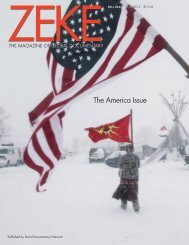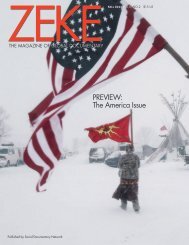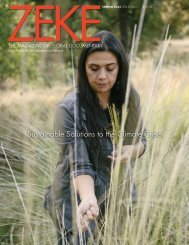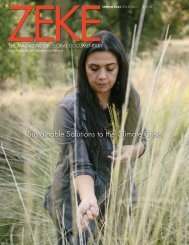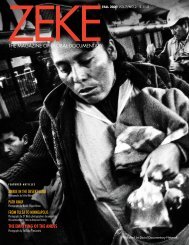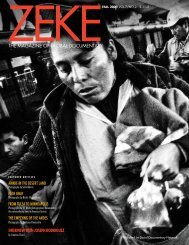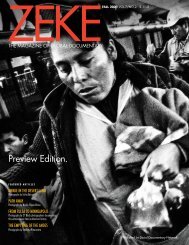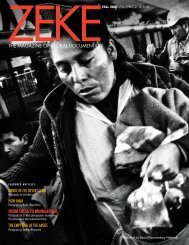ZEKE Magazine: Spring 2023.2
Feature articles on Ecuador by Nicola Ókin Frioli; Ethiopia by Cinzia Canneria, and Ukraine by Svet Jacqueline. Contents: Piatsaw:A Document on the Resistance of the Native Peoples of Ecuadorian Amazon Against Extractivism Photographs by Nicola Ókin Frioli Winner of 2023 ZEKE Award for systemic change Women's Bodies as Battlefield Photographs by Cinzia Canneri Winner of 2023 ZEKE Award for documentary photography Too Young to Fight, Ukraine Photographs by Svet Jacqueline Picturing Atrocity: Ukraine, Photojournalism, and the Question of Evidence by Lauren Walsh Interview with Chester Higgins by Daniela Cohen
Feature articles on Ecuador by Nicola Ókin Frioli; Ethiopia by Cinzia Canneria, and Ukraine by Svet Jacqueline.
Contents:
Piatsaw:A Document on the Resistance of the Native Peoples of Ecuadorian Amazon Against Extractivism
Photographs by Nicola Ókin Frioli
Winner of 2023 ZEKE Award for systemic change
Women's Bodies as Battlefield
Photographs by Cinzia Canneri
Winner of 2023 ZEKE Award for documentary photography
Too Young to Fight, Ukraine
Photographs by Svet Jacqueline
Picturing Atrocity: Ukraine, Photojournalism, and the Question of Evidence
by Lauren Walsh
Interview with Chester Higgins
by Daniela Cohen
You also want an ePaper? Increase the reach of your titles
YUMPU automatically turns print PDFs into web optimized ePapers that Google loves.
BOOK
REVIEWS
CHRIS KILLIP
Thames and Hudson, 2023
256 pages / $75
The book opens with two softly lit,
full bleed head and shoulder portraits
of a young brother and sister.
The faces stare back at us, one (fouryear
old Chris), with a slight smile, a
hint of rascal, open with possibility. The
other, (five-year old Anthean) is already
set, tinged with sadness, maybe a bit of
anger, resigned to a life without possibilities.
It is impossible not to wonder
what happened to them.
This begins our journey through Chris
Killip, the aptly titled monograph of one
of Britain’s most important, but least well
known, documentary photographers.
Killip’s black and white images, a mix of
portraiture and candid reportage, are an
empathetic rendering of working class
life in 1970s and 1980s Britain when
jobs disappeared and communities were
destroyed by gentrification and then a
spiral into poverty.
The book is divided into four chapters
that roughly mirror Killip’s main projects:
work from the Isle of Man; the Edgelands,
which included projects from Askam,
Skinninggrove and the seacoalers from
Lynemouth; the North Country; and The
Last Stories, a hodgepodge of work made
later in Killip’s life. Each section features
an essay either about Killip or his work.
Killip’s images do what traditional
documentary photography does best:
create an origami of time as past
present and future converge and unfold
like warped spacetime. He describes
photographs as “a chronicle of a death
foretold’ and that awareness is clear in
his photographs. It is not only the death
of the person, but the death of a way of
life. These are people to whom history
happened.
Killip photographed with a large
format camera, not the traditional 35mm
of his peers. The detail and expanded
tonality from a large negative, while not
so apparent in the book, is on display in
the amazing retrospective and traveling
exhibit at the Photographer’s Gallery
Cookie in the snow, Seacoal Camp, Northumbria, 1984 © Chris Killip Photography Trust/Magnum Photos
in London, curated by Ken Grant and
Tracy Marshall-Grant. (The book is
an expanded exhibition catalogue.)
The prints are exquisite and proof that
whenever possible we need to see
photographs on the wall.
In part because Killip was not
shooting with a 35mm camera, his work
is quintessential slow documentary. The
simple act of setting up a bulky camera
on a tripod creates a performative
space for the subject and photographer.
Often, we characterize portraits as either
mirroring the subject or revealing the
photographer. His do both. Also, these
are not extractive images. Killip knows
the people and places and because
of that we know them and him. The
photographs are familiar and intimate,
and you sense that Killip would return to
visit these people without his camera.
A lot of current debate in the
documentary world swirls around the
idea of insider versus outsider or who
should be allowed to photograph whom.
Killip’s images tilt towards the value of
being an insider or being willing to stay
long enough to become one. While
clearly an insider for the photographs he
took on the Isle of Man (where he grew
up), he became an insider for his other
projects through persistence.
For example, in his project on the seacoalers,
(men who make their living by
driving horse-drawn carts to collect and
sell coal washed up on beaches when the
tide recedes), he was chased off several
times until a serendipitous meeting at a
local pub with a man he had previously
photographed gave him a slight inside
edge. Still he didn’t feel he understood
the seacoalers well enough, so he bought
a caravan and parked it on the beach
at Lynemouth so he would have a sense
of the rhythm of the place, and to better
understand these men, he often invited
them into his warm caravan for tea.
This is very slow photography indeed
and because of that he makes the random,
accidental, and fragmentary details
of everyday existence meaningful while
preserving the actual details of the scene.
Killip’s image, “Cookie in the snow,
1984” —only possible because he was
living in the caravan—features “Cookie”
looking like a black apparition, leaning
into the wind and snow carrying a bag
(maybe of coal). The image is so visceral
we feel what a bone-weary job Cookie
has.
If the book has a weakness, it is the
editing and design. Less is more, but not
in this book. Trying to include too many
photographs, while understandable for
a retrospective, forces a design of often
cramming too many small images on
a page, which doesn’t do any of them
justice, or the odd choice of always
staggering two vertical images per page,
which creates a checkboard pattern. The
design works best with one image per
page, large enough for us to get lost in
the details of a large negative.
—Michelle Bogre
58 / ZEKE SPRING 2023








